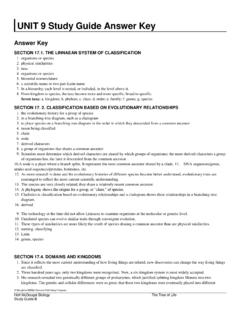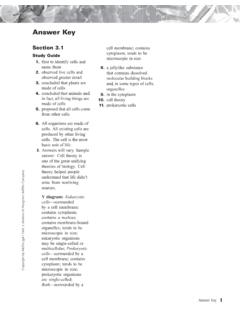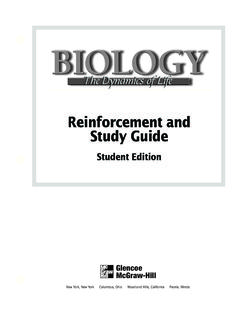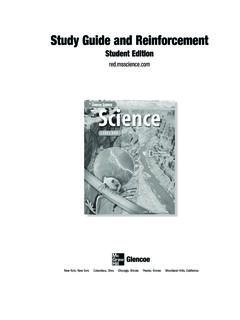Transcription of Chapter Reinforcement and Study Guide A View of the Cell ...
1 UNIT 3 Chapter 7A View of the Cell47 NameDateClassCopyright Glencoe/McGraw-Hill, a division of The McGraw-Hill Companies, your textbook, read about the history of the cell each statement in Column A, write the letter of the matching item in Column first scientist to describe living cells asseen through a simple two or more glass lenses to magnifyeither living cells or prepared scientist who observed that cork was composed of tiny, hollow boxes that he called scientist who concluded that all plants are composed of scientist who concluded that all animals are composed of microscope that allowed scientists to view moleculesIn your textbook, read about the two basic cell the table by checking the correct column for each View of the CellChapter7 ChapterSection The Discovery of CellsReinforcement and Study GuideReinforcement and Study GuideColumn that have cells lacking internal membrane-bound not have a either single-celled or made up of many are single-celled that have cells containing organelles48 Chapter 7A View of the CellUNIT 3 NameDateClassCopyright Glencoe/McGraw-Hill, a division of The McGraw-Hill Companies, your textbook, read about maintaining a each of the terms below just once to complete the membranehomeostasisorganismbalanceselect ive permeabilityLiving cells maintain a (1)_____ by controlling materials that enter and leave.
2 Without this ability, the cell cannot maintain (2)_____ and will die. The cell must regulate internal con-centrations of water, (3)_____ , and other nutrients and must eliminate waste in a cell is maintained by the (4)_____ , which allows only certain particles to pass through and keeps other particles out. This property of a membrane is known as(5)_____ . It allows different cells to carry on different activities within thesame(6)_____ . In your textbook, read about the structure of the plasma each statement below, write trueor structure and properties of the cell wall allow it to be selective andmaintain plasma membrane is a bilayer of lipid molecules with protein moleculesembedded in phospholipid molecule has a nonpolar, water-insoluble head attached toalong polar, soluble fluid mosaic model describes the plasma membrane as a structure thatis liquid and very plasma membranes can contain cholesterol, which tends to makethe membrane more proteins span the cell membrane.
3 Allowing the selectively perme-able membrane to regulate which molecules enter and leave a at the inner surface of the plasma membrane attach the membraneto the cell s support structure, making the cell View of the Cell, continuedChapter7 Reinforcement and Study GuideReinforcement and Study GuideSection The Plasma MembraneUNIT 3 Chapter 7A View of the Cell49 NameDateClassCopyright Glencoe/McGraw-Hill, a division of The McGraw-Hill Companies, your textbook, read about cellular boundaries; nucleus and cell control; assembly, transport, and storagein the cell; and energy the table by writing the name of the cell part beside its structure/function. A cell partmay be used more than View of the Cell, continuedChapter7 Reinforcement and Study GuideReinforcement and Study GuideSection Eukaryotic Cell StructureStructure/FunctionCell membrane-bound, fluid-filled stacked, flattened membrane sites of protein folded membrane that forms a network of interconnected compartments in the clear fluid inside the that manages cell functions in eukaryotic chlorophyll, a green pigment that traps energy from sunlight and gives plants their green excess or worn-out cell parts, food particles, and invading viruses or bumps located on the endoplasmic temporary storage of food, enzymes, and waste , protective structure that gives the cell its shape in plants, fungi.
4 Most bacteria, and some a usable form of energy for the proteins chemically, then repackages inner membranes arranged in stacks of membranous sacs called organelles that store starches or lipids or that contain pigments50 Chapter 7A View of the CellUNIT 3 NameDateClassCopyright Glencoe/McGraw-Hill, a division of The McGraw-Hill Companies, your textbook, read about structures for support and if the statement is true. If it is not, rewrite the italicized part to make it have a support structure within the cytoplasmcalled the exoskeletonis composed of thin, fibrous elements that form a framework for the the cytoskeleton are thin, hollow cylinders made of and flagella are cell surface structures that are adapted for short, numerous, hairlike projections from the plasma are longer and morenumerous than multicellularorganisms, cilia and flagella are the major means of prokaryoticcells, both cilia and flagella are composed of titles for each of the generalized diagrams and then label the parts.
5 Use these choices: plantcell, animal cell, plasma membrane, chloroplast, lysosome, large vacuole, cell wall. A View of the Cell, continuedChapter7 Reinforcement and Study GuideReinforcement and Study GuideSection Eukaryotic Cell Structure 24. _____25. _____26. _____27. _____28. _____29. _____30. _____Copyright Glencoe/McGraw-Hill, a division of The McGraw-Hill Companies, tu libro de texto, lee sobre la historia de la teor a la letra de la columna B que corresponde a cada enunciado de la columna primer cient fico que describi las c lulas, vistas a trav s de un microscopio dos lentes para aumentar el tama o de las im genes de c lulas vivas o de laminillas fico que observ que el corcho estaba formado por celdillas vac as que denomin c fico que concluy que todas las plantas estaban formadas por c fico que concluy que todos los animales estaban formados por c que permiti a los cient ficos observar mol culasEn tu libro de texto.
6 Lee sobre los dos tipos b sicos de c la tabla indicando la columna correspondiente a cada vistazo a la c lulaCap tulo7 Cap tuloSecci n El descubrimiento de la c lulaRefuerzo y Gu a de estudioRefuerzo y Gu a de estudioColumna electr formados por c lulas que carecen de estructuras membranosas tienen n n formados por una o muchas c general son organismos formados por c lulas que tienen organelosUNIDAD 3 CAP TULO 7Un vistazo a la c lula51 NombreFechaClaseCopyright Glencoe/McGraw-Hill, a division of The McGraw-Hill Companies, tuloEn tu libro de texto, lee sobre c mo mantiene la c lula el cada t rmino una sola vez para completar el p plasm ticahomeostasisorganismoequilibriopermea bilidad selectivaLas c lulas vivas mantienen un (1)_____ controlando los materiales que entran y salen de ella.
7 Sicarecieran de esta capacidad, las c lulas no podr an mantener su (2)_____ y morir an. Lac lula debe regular la concentraci n interna de agua, (3)_____ y otros nutrientes y debe tambi n eliminar sus desechos. La (4)_____ mantiene la homeostasis de la c lula, locual permite que s lo ciertas part culas entren a la c lula y evita que otras salgan. Esta propiedad de lac lula se conoce como (5)_____ y ayuda a que diferentes c lulas cumplan diferentes funciones dentro de un mismo (6)_____ . En tu libro de texto, lee sobre la estructura de la membrana plasm si cada enunciado es verdaderoo estructura y las propiedades de la pared celular le permiten ser selectiva ymantener la membrana plasm tica es una capa doble de mol culas de l pidos con pro-te nas mol cula de un fosfol pido tiene una cabeza no polar, insoluble en agua,unida al extremo o cola que es polar y modelo del mosaico fluido describe la membrana plasm tica como unaestructura l quida y muy r membrana plasm tica de las c lulas eucariotas puede contener colesterol.
8 Lo que ayuda a una mayor estabilidad en las prote nas de transporte atraviesan la membrana celular y le confieren per-meabilidad selectiva que regula las mol culas que entran y salen de la c prote nas de la superficie interna de la membrana plasm tica unen la mem-brana a la estructura de soporte de la c lula, haciendo que la c lula sea r vistazo a la c lula, continuaci nCap tulo7 Refuerzo y Gu a de estudioRefuerzo y Gu a de estudioSecci n La membrana plasm ticaNombreFechaClase52 CAP TULO 7Un vistazo a la c lulaUNIDAD 3 Copyright Glencoe/McGraw-Hill, a division of The McGraw-Hill Companies, tuloEn tu libro de texto, lee sobre los l mites de la c lula; el n cleo y el control celular; el ensamblaje, el trans-porte y el almacenamiento en la c lula y los transformadores de energ la tabla escribiendo el nombre de la parte de la c lula que corresponde a cada descripci n en la primera columna.
9 Se puede usar cada parte m s de una vistazo a la c lula, continuaci nCap tulo7 Refuerzo y Gu a de estudioRefuerzo y Gu a de estudioSecci n Estructura de la c lula eucari ticaEstructura/Funci nParte de la c membranoso lleno de membranosos planos y semejantes a monedas donde ocurre la s ntesis de prote plegada que forma dentro del citoplasma una red de compartimientos claro dentro de la c que controla las funciones de las c lulas clorofila, un pigmento verde que atrapa la energ a de la luz solar y que proporciona a las plantas su color las partes gastadas o sobrantes de una c lula, las part culas alimenticias y los virus o os gr nulos localizados en el ret culo endopl como almac n temporal de alimentos, enzimas y protectora firme que da forma a las c lulas de plantas, hongos, la mayor a de las bacterias y algunos una forma de energ a que la c lula puede qu micamente las prote nas y las envuelve o membranas internas que forman una estructura con forma de sacos planos apilados llamados de la planta que almacenan almidones o l pidos, o que contienen pigmentosUNIDAD 3 CAP TULO 7Un vistazo a la c lula53 NombreFechaClaseCopyright Glencoe/McGraw-Hill, a division of The McGraw-Hill Companies, tuloEn tu libro de texto, lee acerca de las estructuras de sost n y locomoci el enunciado es verdadero, escribe verdadero.
10 De lo contrario, modifica la secci n en it licas parahacer verdadero el c lulas poseen una estructura de soporte dentro del citoplasmallamada exoesqueletoest compuesto de elementos fibrosos y delgados que dan forma a la c microt bulosdel citoesqueleto son cilindros delgados y huecos compuestos de prote cilios y los flagelos son estructuras de la superficie de la c lula adaptadas para la respiraci n flagelosson proyecciones cortas y numerosas de la membrana plasm flagelos son m s largos y m snumerosos que los los organismos multicelulares,los cilios y los flagelos son los principales medios de locomoci cilios y flagelos de las c lulas procariotasest n compuestos de microt el tipo de c lula representado por cada diagrama y rotula las partes.









